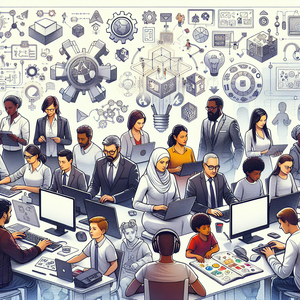The Evolution of Educational Games and Their Impact on Learning

The concept of using games for education is not new. In fact, educational games have been around for centuries, with early examples including board games and card games designed to teach various subjects. Games like chess have long been used to foster strategic thinking, while simple card games have helped children learn mathematics and language skills. However, the landscape began to shift dramatically in the late 20th century with the advent of computers and video games. The 1980s and 1990s witnessed the introduction of computer-based educational games, which offered interactive experiences that traditional methods could not match. Titles like "Oregon Trail" and "Math Blaster" allowed students to learn subjects in a fun and engaging way, laying the groundwork for future developments. These early educational games paved the way for a growing acceptance of games as legitimate educational tools.
The Rise of Gamification in Education
The term "gamification" refers to the application of game design elements in non-game contexts, and its incorporation into education has gained significant traction in recent years. This shift is largely attributed to advancements in technology and a growing understanding of how students learn. Research indicates that gamification can increase motivation, enhance retention, and improve overall learning experiences. According to a study published in the "Journal of Educational Psychology," gamified learning environments can lead to higher levels of student engagement and achievement. By tapping into the natural human desire for competition, achievement, and social interaction, educational games create a dynamic environment that fosters deeper learning. This has led to widespread implementation of gamified elements in classrooms, ranging from reward systems to competitive quizzes that keep students engaged.
Gimkit: A Case Study in Modern Educational Gaming
One of the most notable platforms in the realm of educational gaming is Gimkit. Launched in 2017, Gimkit allows educators to create interactive quizzes that students can play individually or in teams. The game's unique mechanics, such as earning in-game currency to buy power-ups and compete against peers, make learning captivating and interactive. Teachers across the globe have reported positive outcomes from implementing Gimkit in their classrooms. For instance, a high school math teacher noted that students who previously struggled with concept retention showed remarkable improvement after engaging with Gimkit's game-based assessments. The platform's adaptability allows educators to tailor content to meet specific learning objectives, ensuring that students remain both challenged and motivated. Moreover, Gimkit incorporates real-time feedback and analytics, enabling educators to track student progress and identify areas needing improvement. This data-driven approach empowers teachers to refine their instructional methods and better support student learning.
The Psychological and Educational Theories Behind Gamification
Several psychological theories support the effectiveness of gamification in education. One such theory is Self-Determination Theory (SDT), which posits that people are most motivated when they experience autonomy, competence, and relatedness. Educational games like Gimkit empower students by allowing them to take charge of their learning, practice their skills, and collaborate with peers, all of which enhance intrinsic motivation. Another relevant theory is the Flow Theory, developed by psychologist Mihaly Csikszentmihalyi. This theory suggests that individuals experience optimal engagement and enjoyment when they are fully immersed in an activity that balances challenge and skill. Gamified learning environments, with their interactive and adaptive nature, help students achieve this state of flow, promoting deeper learning and retention. Additionally, cognitive load theory highlights the importance of managing the amount of information students must process at one time. Educational games can break down complex topics into manageable parts, allowing students to learn at their own pace while still enjoying the learning process.
The evolution of educational games has significantly impacted the way students learn, making education more engaging and effective. Platforms like Gimkit exemplify the potential of gamification to enhance learning outcomes by leveraging competition, collaboration, and interactive challenges. As technology continues to advance, it is crucial for educators to embrace these innovative tools to foster a love for learning and equip students with the skills they need for the future. The journey of educational games is far from over, and their role in shaping the educational landscape will undoubtedly continue to grow, paving the way for a more interactive, personalized, and effective learning experience. As educators recognize the power of gamification, the potential for improved educational outcomes will only broaden, illustrating the profound impact of games on learning.
Educational Game Designer
Kahoot!, Nearpod
Core Responsibilities
Develop engaging and interactive educational games that align with curriculum standards and learning objectives.
Collaborate with educators and subject matter experts to ensure content accuracy and educational value.
Test and iterate game mechanics based on user feedback and learning outcomes.
Required Skills
Strong understanding of game design principles and educational theory.
Proficiency in programming languages (e.g., Unity, C#, JavaScript) and game development tools.
Ability to create compelling storylines and user experiences that foster deep learning.
Gamification Specialist
Classcraft, Edmodo
Core Responsibilities
Design and implement gamification strategies for educational platforms to enhance student engagement and motivation.
Analyze user data to assess the effectiveness of gamified elements and make data-driven improvements.
Conduct workshops and training sessions for educators on integrating gamification into their teaching practices.
Required Skills
Expertise in user experience (UX) design and knowledge of game mechanics.
Familiarity with learning management systems (LMS) and analytics tools.
Strong communication skills to effectively convey concepts to educators and stakeholders.
Instructional Designer with Gamification Focus
Coursera, Udacity
Core Responsibilities
Create engaging and interactive e-learning content utilizing gamification techniques to enhance learning experiences.
Collaborate with subject matter experts to design assessments that measure learning outcomes effectively.
Stay current with educational trends and adapt instructional strategies to meet diverse learner needs.
Required Skills
Proficiency in instructional design models (e.g., ADDIE, SAM) and familiarity with e-learning development tools (e.g., Articulate Storyline, Adobe Captivate).
Strong understanding of adult learning principles and gamification theories.
Experience with multimedia production (videos, animations) to enhance educational content.
Data Analyst in Educational Technology
Pearson, McGraw-Hill
Core Responsibilities
Analyze user data from educational games and platforms to identify trends in student engagement and learning outcomes.
Develop reports and dashboards to provide insights into the effectiveness of gamified learning approaches.
Collaborate with product development teams to refine educational tools based on data-driven findings.
Required Skills
Proficiency in data analysis tools (e.g., SQL, R, Python) and visualization software (e.g., Tableau, Power BI).
Strong analytical and problem-solving skills to interpret complex datasets.
Understanding of educational assessment and evaluation metrics.
UX/UI Designer for Educational Software
Quizlet
Core Responsibilities
Design intuitive user interfaces and experiences for educational games and platforms to enhance usability and student engagement.
Conduct user research and usability testing to gather feedback and iterate on designs.
Collaborate with developers and educational stakeholders to create visually appealing and functional educational tools.
Required Skills
Proficiency in design tools (e.g., Sketch, Figma, Adobe Creative Suite) and a strong portfolio showcasing educational applications.
Understanding of user-centered design principles and accessibility standards.
Ability to create wireframes, prototypes, and high-fidelity designs that reflect educational needs.


